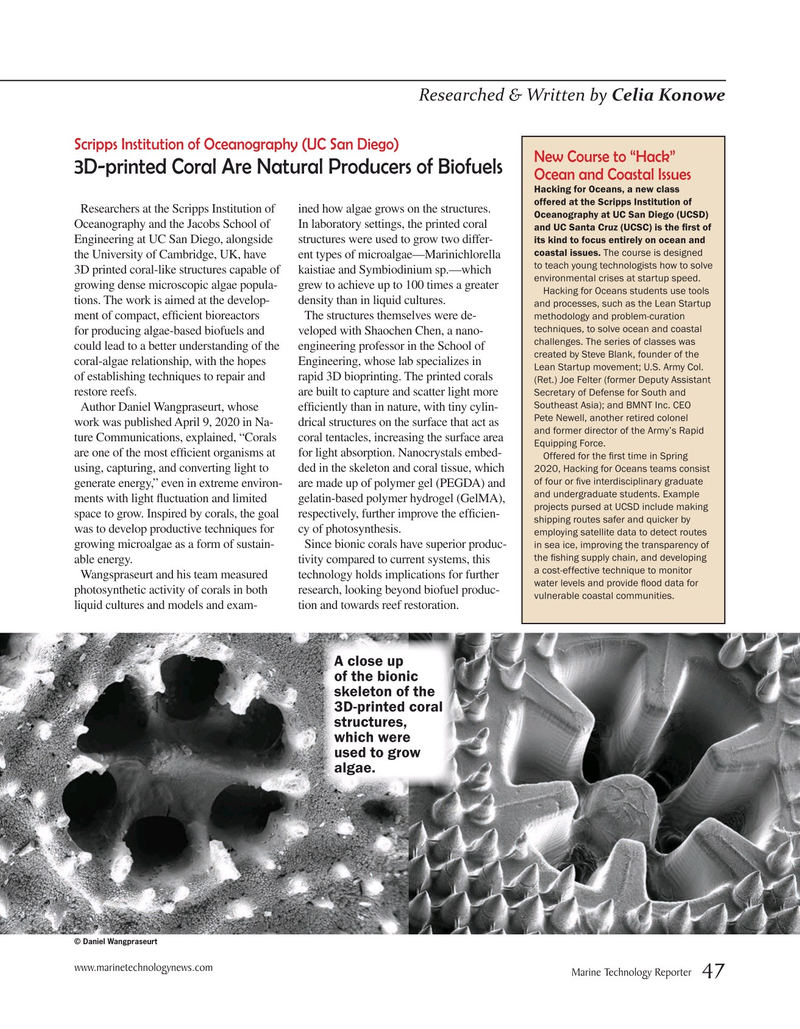
Page 47: of Marine Technology Magazine (June 2020)
Read this page in Pdf, Flash or Html5 edition of June 2020 Marine Technology Magazine
Researched & Written by Celia Konowe
Scripps Institution of Oceanography (UC San Diego)
New Course to “Hack” 3D-printed Coral Are Natural Producers of Biofuels
Ocean and Coastal Issues
Hacking for Oceans, a new class offered at the Scripps Institution of
Researchers at the Scripps Institution of ined how algae grows on the structures.
Oceanography at UC San Diego (UCSD)
Oceanography and the Jacobs School of In laboratory settings, the printed coral and UC Santa Cruz (UCSC) is the frst of
Engineering at UC San Diego, alongside structures were used to grow two differ- its kind to focus entirely on ocean and coastal issues. The course is designed the University of Cambridge, UK, have ent types of microalgae—Marinichlorella to teach young technologists how to solve 3D printed coral-like structures capable of kaistiae and Symbiodinium sp.—which environmental crises at startup speed. growing dense microscopic algae popula- grew to achieve up to 100 times a greater
Hacking for Oceans students use tools tions. The work is aimed at the develop- density than in liquid cultures. and processes, such as the Lean Startup ment of compact, effcient bioreactors The structures themselves were de- methodology and problem-curation techniques, to solve ocean and coastal for producing algae-based biofuels and veloped with Shaochen Chen, a nano- challenges. The series of classes was could lead to a better understanding of the engineering professor in the School of created by Steve Blank, founder of the coral-algae relationship, with the hopes Engineering, whose lab specializes in
Lean Startup movement; U.S. Army Col. of establishing techniques to repair and rapid 3D bioprinting. The printed corals (Ret.) Joe Felter (former Deputy Assistant restore reefs. are built to capture and scatter light more
Secretary of Defense for South and
Southeast Asia); and BMNT Inc. CEO
Author Daniel Wangpraseurt, whose effciently than in nature, with tiny cylin-
Pete Newell, another retired colonel work was published April 9, 2020 in Na- drical structures on the surface that act as and former director of the Army’s Rapid ture Communications, explained, “Corals coral tentacles, increasing the surface area
Equipping Force. are one of the most effcient organisms at for light absorption. Nanocrystals embed-
Offered for the frst time in Spring using, capturing, and converting light to ded in the skeleton and coral tissue, which 2020, Hacking for Oceans teams consist of four or fve interdisciplinary graduate generate energy,” even in extreme environ- are made up of polymer gel (PEGDA) and and undergraduate students. Example ments with light fuctuation and limited gelatin-based polymer hydrogel (GelMA), projects pursed at UCSD include making space to grow. Inspired by corals, the goal respectively, further improve the effcien- shipping routes safer and quicker by was to develop productive techniques for cy of photosynthesis. employing satellite data to detect routes growing microalgae as a form of sustain- Since bionic corals have superior produc- in sea ice, improving the transparency of the fshing supply chain, and developing able energy. tivity compared to current systems, this a cost-effective technique to monitor
Wangspraseurt and his team measured technology holds implications for further water levels and provide food data for photosynthetic activity of corals in both research, looking beyond biofuel produc- vulnerable coastal communities. liquid cultures and models and exam- tion and towards reef restoration.
A close up of the bionic skeleton of the 3D-printed coral structures, which were used to grow algae. © Daniel Wangpraseurt www.marinetechnologynews.com
Marine Technology Reporter 47

 46
46

 48
48
